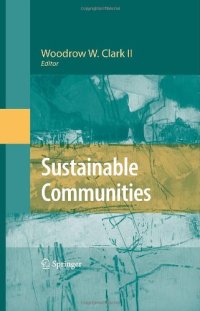
Ebook: Sustainable Communities
- Tags: Sustainable Development, Conservation Biology/Ecology, Environmental Management, Nature Conservation, Environmental Engineering/Biotechnology, Atmospheric Protection/Air Quality Control/Air Pollution
- Year: 2009
- Publisher: Springer-Verlag New York
- Edition: 1
- Language: English
- pdf
Written as a professional reference book and a case textbook for advanced undergraduate and graduate students in a variety of disciplines, Sustainable Communities contains detailed case studies of communities in U.S.A., Europe, and Asia that have become sustainable. In most cases, these communities are either off the central power grid or will be by 2010, and are examples of what regions, cities, towns, and communities—such as colleges, businesses and shopping malls—can do to become sustainable.
The book provides a vast amount of materials and data including design, and the legal, economic, and technologic aspects of how environments become sustainable. It provides the general public with a multi-disciplinary perspective and understanding of sustainable development from actual cases, along with some well-established resources and tools.
With the international variety of detailed cases and specific analysis of practical sustainability approaches, Sustainable Communities provides guidance and inspiration for everyone from students and academics to policy makers and economists.
About the Author:
Woodrow W. Clark II, MA3, Ph.D is a Qualitative Economist and co-winner of the Nobel Peace Prize for his work on the UN Intergovernmental Panel for Climate Change. He is the founder of Clark Strategic Partners, a consulting firm in Los Angeles that focuses on renewable energy and technologies along with a team of experts in public policy, accounting, economics, law, and construction. Dr. Clark was also a Visiting Professor of Sustainable Development at the University of California, Los Angeles and Riverside.
The book starts with a discussion of global warming and climate change. The problem is well documented. Part One gives background for sustainable developments and gives studies of proven, substantiated and documented solutions. The time to act has begun. The “Green Revolution” has begun. Some authors call it The Third Industrial Revolution (Rifkin, 2005) since in the 21st century the industrially developed world has begun to move rapidly from fossil fuels (The Second Industrial Revolution) to renewable energy generation, storage technologies, and sustainable communities. Now is the time to understand and learn the tools that make sustainable communities of all kinds real. The book provides a vast, but not the total, amount of materials and data. The intent is to give students of sustainable development some well-established resources and tools. By 2008, the concept of “Green” had been so much in marketing and product services that it lost its meaning. The “branding” of green meant a whole new industrial sector suddenly emerged globally. However, the proof that there is both a Green Revolution and actual solutions to global warming must be seen in those sustainable communities who have existed, grown or developed using tested tools for sustainability. One of the key tools is the concern for conservation of natural resources, energy efficiency and the use of renewable energy systems (solar, wind, geothermal and bio-mass among others) along with storage devices for power generation. Communities in Europe and Asia have led the way historically. The book presents actual cases of sustainable communities. The case of Frederikshavn in Denmark (Chapter # 6) clearly illustrates how small towns and villages can be sustainable. Far more intuitive and with common sense, Dos Lagos in California (Chapter #4) demonstrates how concern for the natural environment can create a mix-use community of homes, shops, offices and a golf course. Far more planned and strategic are the nine college campuses of the Los Angeles Community College District (Chapter #3) who recognized that public policy and that sector must lead the private sector by example as well as by proving the tools and economics of sustainable communities. And the private sector took note. A number of private companies from Safeway with its 20+ energy independent storage facilities to Toyota with Platinum LEED (Leadership in Environment and Energy Design) USA Headquarters in Torrance, California. Honda was not far behind with its "Green Hydrogen" Refueling station that electronizes solar energy into hydrogen for its hydrogen fuel cell cars. The Green Revolution could be seen with the hybrid cars that led Toyota to be the No #1 Auto maker. Part Two of the book reviews the tools needed to make sustainable communities anywhere in the world. The key one is the technology (s) from science and engineering (Chapter #8). All too often people do not know that there are environmentally sound technologies that exist today (Clark, 2000) to make communities sustainable. Then when the political leaders discover that the technologies exist they argue that the costs are too high. Not true. And certainly not true today as Chapter #9 clearly demonstrates. There is the need to rethink basic cost benefit analyses for goods and services as being in the short term (2-3 years) into life cycle analyses (1-20 years) along with triple bottom line benefits and externality economic impacts on health, pollution and the atmosphere. In the end sustainable communities must be just that: capable of producing and using their own resources. Global warming starts and can end locally. If they need resources from outside or a long distance away, then those needs must be environmentally sound in terms of the goods themselves. And especially they must be sustainable in terms of transportation and services. This local and global change means new paradigms and approaches in public policy, environmentally sound technologies, economics and systems must be implemented today. Such a sustainable perspective will reverse global warming and mitigate global warming.